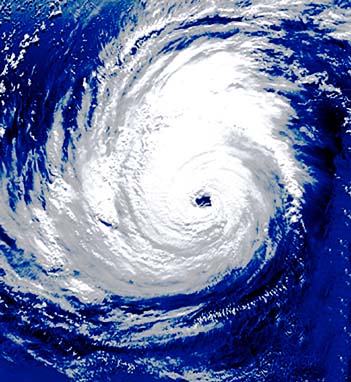
Vigilance urged as
hurricane season nears
Hurricane forecasters are predicting a typical season of four to five tropical cyclones in the central Pacific this year.
National Oceanic and Atmospheric Administration officials said one hurricane, two tropical storms and one or two tropical depressions usually appear between June 1 and Nov. 30.
"But we need to be aware that that can change as we move through the season depending upon the atmospheric and oceanic conditions that could develop in July or August," Jim Weyman, director of NOAA's Central Pacific Hurricane Center, said in announcing the forecast yesterday.
A hurricane will hit again in the future, Weyman said. "That is not just calling wolf. That is a fact."
Though forecasters are unable to tell whether a hurricane will strike this year, next year or in 10 years, they stressed the importance of being prepared.
The 2003 hurricane season was described as quiet, with two tropical cyclones and Hurricane Jimena that moved into the central Pacific in late August and passed about 100 miles south of the Big Island during Labor Day weekend. Jimena was considered the first threat to the state in several years.
Hurricane Iniki hit Kauai and Leeward Oahu in September 1992 with sustained winds of 130 mph.
Weyman said residents have since taken a relaxed approach to the possibility of another hurricane hitting the islands.
"New people have moved into your community, people 12 years and younger have never experienced a hurricane and many of the people 12 years and older have really kind of forgotten what devastation a hurricane can bring," he said. "Our job is to make it personal in any way we can. Because the wolf will come someday and we want the people of Hawaii to be the survivors, not the victims."
Prior to Iniki, Hurricane Iwa struck Hawaii in 1982, and Hurricane Dot hit in 1959.
Forecasters are predicting a busy season of 12 to 15 named Atlantic storms this year.
Over the past year, meteorologists have been working on a new tool, called the Interactive Forecast Preparation System/Graphical Editor, that improves the accuracy of wind, rainfall, humidity and surf forecasts.
"It's not really used to forecast hurricanes any better," said NOAA's Andy Nash. "It's to help us provide a more detailed, more precise forecast for the public."
BACK TO TOP |
Isles feel soggier
than usual
The rainy weather the state endured over the past several months was ranked unofficially as the sixth wettest season in the past 30 years, according to an official with the National Weather Service.
"It's been the wettest since the 1996-1997 version of the wet season," said senior hydrologist Kevin Kodama.
This season stands out because it is wetter than normal combined and comes after several years that have been dry, said Kodama.
The standing was based on an average ranking taken from 10 site indicators around the state between October and April.
"Most areas around the state have received near to above normal, in some cases well above normal rain totals between October and April," said Kodama.
The wettest season in Hawaii occurred in 1981-1982, before the 1982-1983 El Nino event.
Stream flow conditions statewide were also at or above their average, according to Rick Fontaine, hydrologist with the U.S. Geological Survey.
Though Hawaii has endured heavy rainfall in recent months, groundwater wells and aquifers "will respond even much slower to increased water from rain than streams will," he said.
BACK TO TOP |
How to prepare for
>> Learn the locations of official shelters.
the hurricane season:
>> Review the working condition of emergency equipment, such as flashlights, battery-powered radios, etc.
>> Ensure that enough nonperishable food and water are on hand to last for at least two weeks.
>> Obtain and store materials, such as plywood and plastic, to properly secure your home.
>> Check for loose and clogged rain gutters and downspouts.
>> Keep trees and shrubbery trimmed. Cut weak branches and trees that could fall or bump against the house.
>> Determine where to move your boat in an emergency.
>> Review insurance policy to ensure it provides adequate coverage.For more information: www.prh.noaa.gov/cphc/pages/hurrsafety.php .
Source: National Oceanic and Atmospheric Administration
Storm names
For tropical storms this year in the eastern North Pacific:>> Agatha
>> Blas
>> Celia
>> Darby
>> EstelleFor tropical storms this year in the Central Pacific:
>> Ioke
>> Kika
>> Lana
>> Maka
>> Neki
Source: National Oceanic and Atmospheric Administration and the U.S. Department of Commerce
